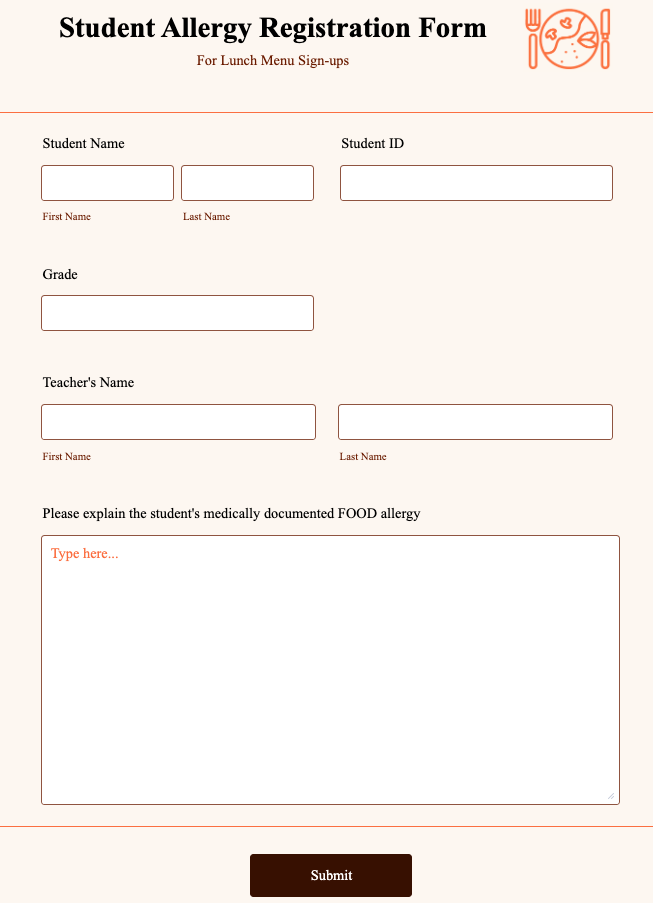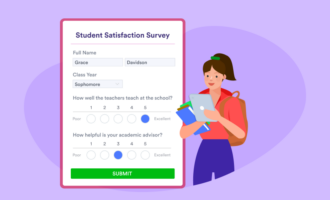Schools can be hazardous environments for children with food allergies. In the past, parents provided teachers and administrators with handwritten lists of food allergies, but these could be lost or forgotten. Today, digital tools make it easier for teachers and staff who interact directly with students to collect, store, and track student health information.
Food allergies are dangerous. Online forms are a viable tool schools can use to better accommodate students with food allergies and respond more quickly to food allergy-related health issues.
Use forms to collect information on student allergies
Knowledge and communication are two of the most important resources needed to manage allergic reactions to food in schools.
According to the CDC’s Voluntary Guidelines for Managing Food Allergies in Schools and Early Care and Education Programs, the first step is to have a coordinated approach between the child and parents, school staff, and a medical practitioner. Schools should request information about student allergies at the beginning of every school year; parents should offer information on their child’s diagnosis, past reactions, and any risk of anaphylaxis. Many parents also submit an emergency plan created by their doctor.
One way to collect this information is by using digital forms. Forms built on Jotform can be integrated with cloud-based data storage systems, like Google Drive or Dropbox. When administrators or teachers collect data on health information via digital forms, this data can be stored in an accessible and familiar tool.
This makes data less likely to get misfiled or lost. Another benefit is that multiple staff — teachers, nurses, and social workers — can access the information at any time and any location. If a teacher has an emergency on a school field trip, they can access a student’s medical history and emergency plan from their smartphone.
Prevention and intervention requires planning
Once the information is collected, the school, parents, and medical professionals can work together to make a prevention and intervention plan in case of emergency.
Students with severe allergies are considered to have a disability and are qualified for a 504 plan. The 504 plan, along with the Individual Health Care Plan, are preventative plans to safely include kids in class activities, explains Thanita Glancey at Allergic Living. This plan will help parents request that certain foods never be brought into the classroom, outline medical protocols, and include policies on how to handle bullying related to the child’s disability.
Even if school administrators and teachers take every step necessary to prevent an emergency, there’s still a risk of allergic reaction. Schools need to have policies and go-to people in place for emergencies.
The school nurse is pivotal in making sure school staff are ready to respond to an allergic reaction. “A school nurse can teach all staff about the signs and symptoms of a serious allergic reaction and who among school personnel are equipped to provide emergency medication,” says retired registered nurse Jessica Gerdes. Nurses can also train students with allergies and school staff how to use an epinephrine auto-injector.
School nurses can use forms to organize trainings and communicate with teachers about students who have allergies. They can ask teachers what kind of experience they have with allergic reactions, what medicine they have access to in the classroom, and request lists of students who are at risk of allergic reactions.
Communication with staff, parents, and students
School staff, parents of students with allergies, and medical professionals are not the only people who need to know about food allergies. The parents of classmates, PTA leaders, and students without allergies also need to be aware of the seriousness of food allergies.
“The majority of food allergy reactions at school happen in classrooms, not cafeterias, due to food-based class projects and food brought into class for celebrations,” explains registered dietician Rima Kleiner. “In fact, foods given to food-allergic children by friends — especially candy and desserts — pose the greatest risk for a food allergy reaction.”
When teachers are aware that students have food allergies, they can avoid food-based projects and take extra precautions on field trips and after-school activities.
When it comes to outside activities, Lindsey Feingold at Consumer Reports says parents and school staff should ask if medicine is accessible during after-school activities and find out how essential medicine will be carried and stored on field trips. This may require extra coordination and communication with parent volunteers. Teachers may know that a specific student is allergic to a food, but without proper planning and communication, an after-school group leader may be unaware.
Teachers can send information to PTA leaders and parent volunteers, educating them on the risks of student allergies. They can use forms that ask leaders and volunteers what snacks they want to bring and what games and rewards they’re planning to make sure that there won’t be any trigger foods at the event. Other parents may not be fully aware of the severity of the allergy, and it may be the school staff’s responsibility to double check that no risky foods will be at special activities.
The nonprofit organization Food Allergy Research and Education has put together several resources on educating parent-teacher organizations and PTAs about food allergies. They suggest discussing food allergies with elementary and high school students so that they understand that even though many of them can eat common foods like peanut butter or wheat, their friends might not be able to.
Check in with parents to create a safe environment
It’s important that your students feel safe and included at school. Dealing with allergies might be a new concept for your staff if you’ve never had students with serious allergies.
Send feedback forms to parents to gauge their opinions on how to prevent health incidents. Ask them if they feel supported in managing their child’s food allergy and what the school should start and stop doing to make every student’s experience better.











































































































Send Comment: